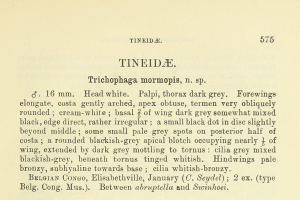3. Weitere Informationen
3.1. Faunistik
Meyrick (1935: 575) meldet seine neue Art aus "Belgian Congo, Elisabethville", heute Lubumbashi ganz im Süden der Demokratischen Republik Kongo.
Auf der Artseite von [afromoths.net (abgefragt 22. Januar 2022)] wird die Art für Afrika sonst nur noch von Gambia und Tansania angeführt und - eingeschleppt - von den Seychellen. Zum Fund dort ist bei Gerlach (1998: 76) zu lesen: "This small moth was found in barn owl (Tyto alba (Scopoli, 1769), pellets collected on Aride by M. Betts in April 1996. Boxes of pellets opened 3 months after collection contained living spiders, pseudoscorpions and moths. Numerous caterpillars were found feeding on the pellets. In addition, there were several pupae and a few emerged moths. Two specimens [...] have been identified as T. mormopis by Dr. G.S. Robinson of the British Museum (Natural History). [...] This is a widespread species with an almost pantropical distribution. It is often found in stored animal fibres or in owl pellets (Robinson pers. comm.). It is believed to have been introduced to many countries."
Aus Europa finde ich nur Angaben aus England: Agassiz et al. (2013: 112) führen die Art bei den "adventive species" und schreiben zu England: "Eleven from Isle of Wight, 1930 from furs. One among feathers from Formosa, 1974. Afro-oriental." Weitere Funde in Europa dürften durchaus möglich sein - doch wer schaut sich schon jede Trichophaga tapetzella so genau an? Gaedike (2019: 42) gelang es allerdings nicht, weitere Belegtiere aus Europa zu finden, weshalb er die Art auch nicht näher besprach.
Außer von Taiwan (= Formosa) wurde die Art noch aus weiteren ostasiatischen Ländern gemeldet. Vor diesem Hintergrund muss Afrika nicht einmal die natürliche Heimat der Art sein.
Die Art wurde auch nach Hawaii eingeschleppt. Zimmerman, E.C. (1978: 305) meldete von dort: "Oahu, Maui. Immigrant. Widely distributed from Africa (type locality: the former Belgian Congo) to India, Ceylon, Malaya, Formosa, and Fiji. First found in Hawaii by D. D. Jensen, who reared specimens in Honolulu in 1944 (Proc. Hawaiian Ent. Soc. 12(2):226, 1945). The identification of the Jensen specimens and other earlier records in the Proceedings of the Hawaiian Entomological Society by Swezey as the tapestry or carpet moth, Trichophaga tapetzella, are incorrect. In 1950, I compared the genitalia of Hawaiian specimens with the collections at the British Museum and found that the species in question is mormopis instead of tapetzella. It is possible, however, that tapetzella may also be present in Hawaii, and determinations should be made with care. The specimens reported on in Hawaii by Jensen were reared from rabbit fur. The larvae spin a silken tube in their host material."
(Autor: Erwin Rennwald)
3.2. Literatur
- Agassiz, D.J.L., Beavan, S.D. & R.J. Heckford (2013): Checklist of the Lepidoptera of the British Isles. - Royal Entomological Society. 206pp.
- Gaedike, R. (2019): Tineidae II (Myrmecozelinae, Perissomasticinae, Tineinae, Hieroxestinae, Teichobiinae and Stathmopolitinae). — In: Karsholt, O., Mutanen, M. & M. Nuss (2019): Microlepidoptera of Europe 9: I-XXIII, 1-248. Leiden – Boston (Brill).
- Erstbeschreibung: Meyrick, E. (1935): Exotic Microlepidoptera 4 (18): 545-576. [London] (Taylor & Francis). [Digitalisat auf biodiversitylibrary.org]
- Gerlach, J. (1998) New and rediscovered animals in Seychelles. — Phelsuma, 6: 74–76. [PDF auf islandbiodiversity.com]
- Zimmerman, E.C. (1978): Insects of Hawaii. Vol. 9 Microlepidoptera. - The University Press of Hawaii, Honolulu. hdl:10125/7338. [zum PDF-Download auf scholarspace.manoa.hawaii.edu (IOH-V09 Microlepidoptera 1of4.pdf)]




![Einzelnachweis in Großbritannien [Verschleppungen 1930 und 1974]](/res/img/flag/gb.gif)





![Vorkommen auf den Seychellen [eingeschleppt]](/res/img/flag/sc.gif)
![Vorkommen in den Vereinigten Staaten von Amerika (USA) [Hawaii eingeschleppt und etabliert]](/res/img/flag/us.gif)
![Vorkommen auf den Galapagos-Inseln (Ecuador) [Roque-Albelo (2006)]](/res/img/flag/ec.gif)



